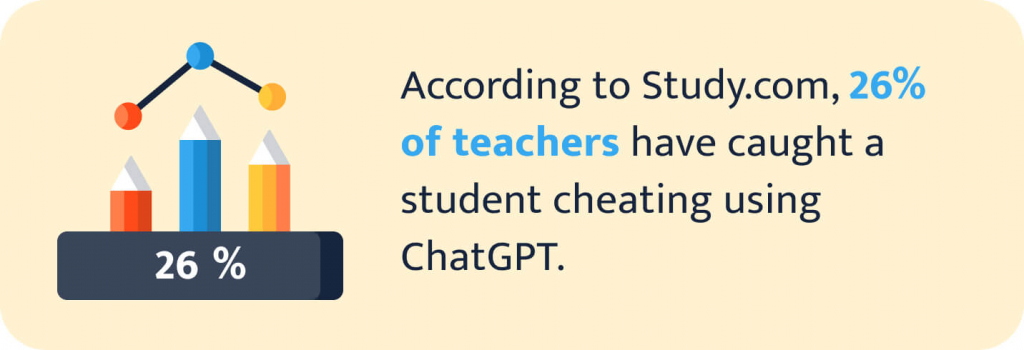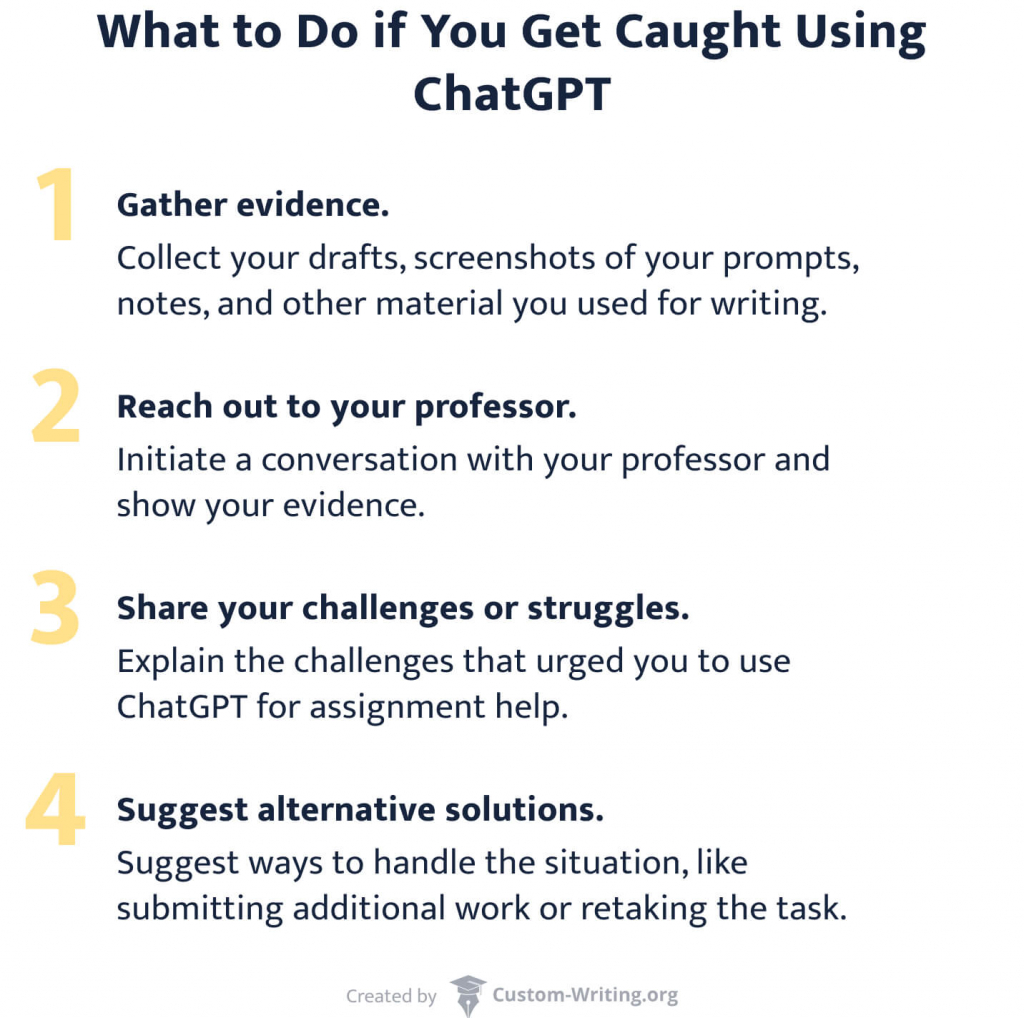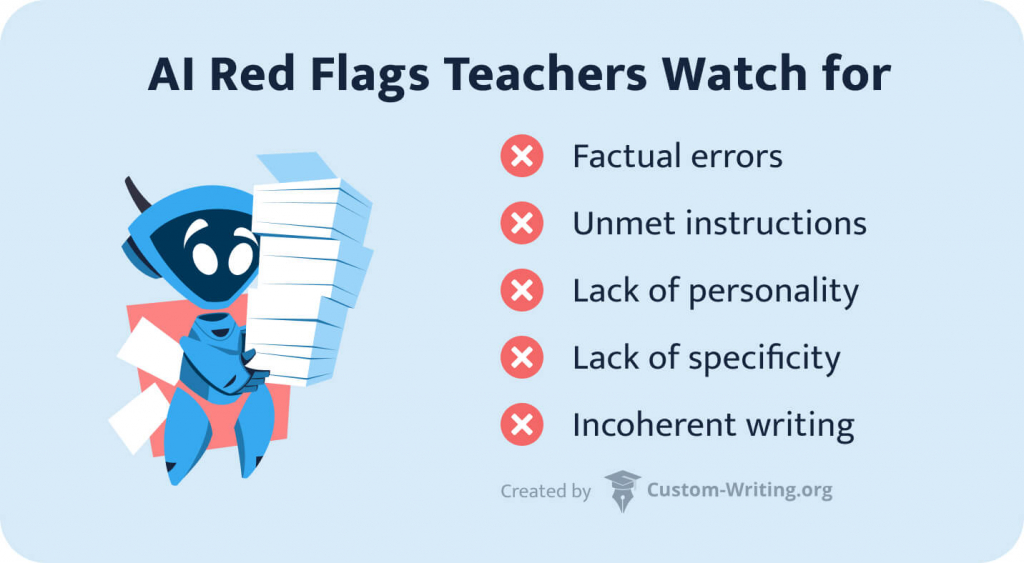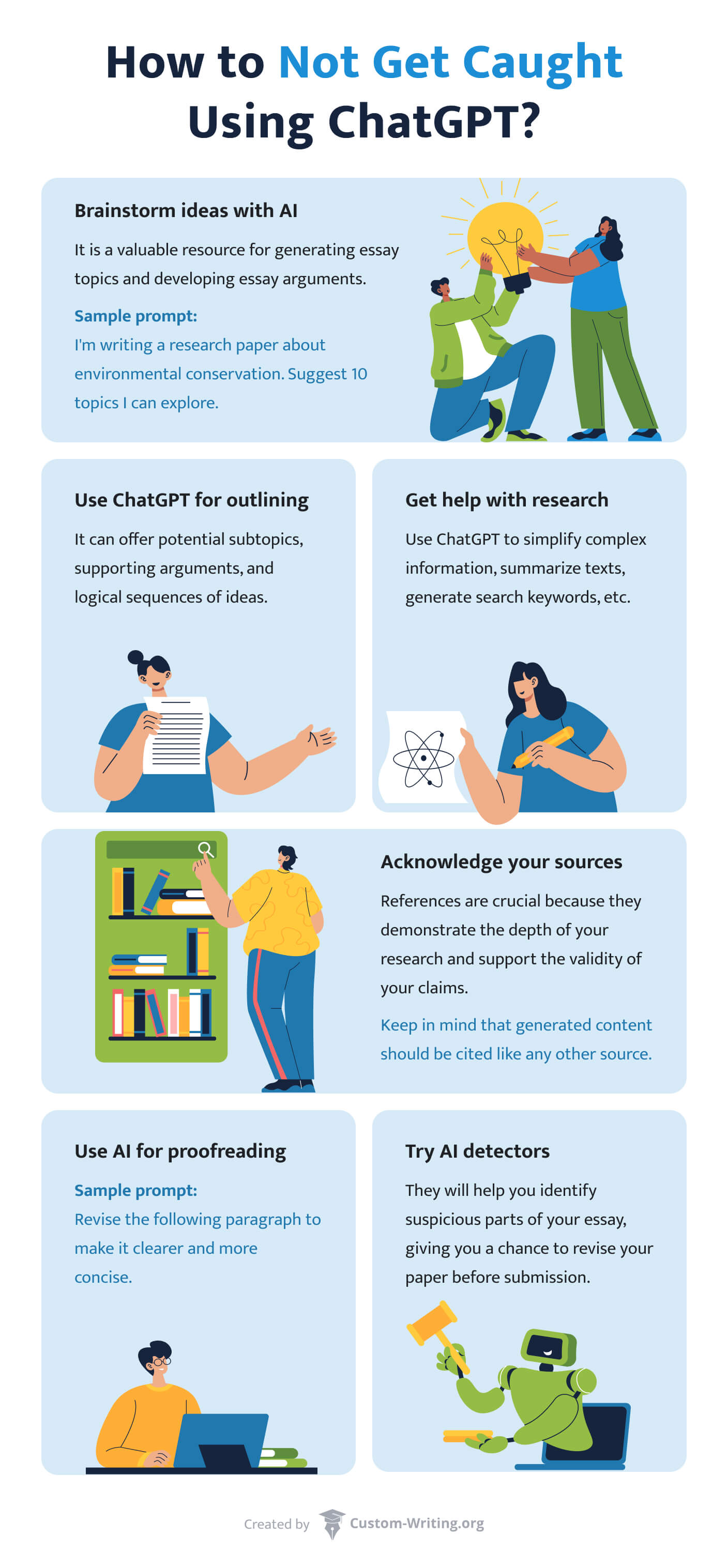You can get caught using ChatGPT for writing assignments if your instructor finds AI-like patterns in your work or if it is marked by a detection tool. Whether you can get kicked out of college for using ChatGPT depends on your school’s policies and the volume of generated content. That said, there are still ethical ways of using AI in college without getting in trouble.
In this article, our custom writing team will share some working tricks to avoid detection while using ChatGPT. With these tips, you are sure to balance it benefits and challenges in an ethical manner. You’ll also find answers to common questions, such as:
- What happens if I get caught using Chat GPT?
- How can teachers detect AI?
- Can I get expelled for using Chat GPT?
We’ll also offer plenty of tips on using AI for essays responsibly.
👨🏫 Can You Get Caught Using Chat GPT for Essays?
Can teachers detect Chat GPT?
Yes, even if you paraphrase the text.
According to Study.com statistics, 26% of teachers have caught a student cheating using ChatGPT.

Some professors have a sixth sense when spotting the sneaky use of AI technologies. For example, they look for inconsistencies in your writing style and language proficiency. If a student suddenly goes from 0 to 100 and produces significantly more advanced or sophisticated work, it may raise suspicion.
Teachers can also use plagiarism detectors to check for content that closely resembles sources on the internet. Even on Turnitin, there’s an AI-detection tool available.
Finally, let’s not forget the conversations between teachers and students. When teachers ask about your writing process and sources of inspiration, they might be playing detective. By doing so, teachers can gain insight into whether you have used ChatGPT and if you have done so ethically.
Here are some real stories from students caught using Chat GPT:
- A Twitter user shared a story about their cousin getting caught using ChatGPT for their English homework. Everything happened because of a single sentence. The 7th grader forgot to edit the chatbot’s response, which contained the phrase, “As an AI language model, I don’t have personal opinions.”
- Darren Hick, a philosophy professor at Furman University, discovered that his student had used ChatGPT to write their essay. The paper referenced facts not taught in class and made nonsensical claims. Hick noted that while the essay was well-written, it contained shockingly wrong facts. The professor named this phenomenon a “really well-written wrong” and claimed it to be the main red flag.
- A college student from the University of Bolton was caught using ChatGPT to write an essay because the bot referenced a book about witches and wizards. Other suspicious references included an academic dissertation from 1952 and a research article from 1957.
So, while it’s not always easy to catch clever AI writing tools at first glance, teachers have their tricks.
🎣 What Happens if You Get Caught Using Chat GPT?
Academic pressures can sometimes lead students to consider misusing AI. However, it’s crucial to remember that abusing ChatGPT is regarded as academic misconduct.
The standard academic misconduct process typically begins with the professor expressing their concerns to the student. If the professor’s suspicions are confirmed, they may escalate the issue to the department chair or academic integrity office. From there, the case may be brought to the Dean’s Office or a disciplinary committee, where a decision will be made regarding the student’s penalty.
Penalties for academic misconduct vary, but here are the most prevalent ones:
- Lower or failing grade on the assignment. It is the most widespread consequence of using AI unethically. A poor grade on a single assignment can considerably affect a student’s overall course standing.
- XF grade for a course. This grade, generally reserved for those guilty of major academic integrity violations, can stain a student’s transcript.
- Probation. It limits students’ academic activities and demands that they meet specific criteria to stay enrolled. Typically, probation can last from one term to a year.
- Suspension. More serious cases may bring about suspension from the college. It bars students from campus activities and classes for one semester or longer.
- Expulsion from the college. It is the most bitter punishment for academic misuse of ChatGPT. It permanently terminates a student’s enrollment. No more educational opportunities at that institution!
- Denial or revocation of a degree. If cheating is disclosed after graduation, a college may withhold the student’s degree. It can significantly damage their career advancement and professional reputation.
The consequences of misusing AI can differ based on various factors, like prior offenses or a specific school’s policies. Not all colleges view using AI tools as automatic misconduct.
Here’s the takeaway: familiarize yourself with your school’s academic integrity policy and understand your professor’s expectations for AI use. This way, you can integrate AI responsibly into your studies and avoid possible risks.
Wondering about other pitfalls of students’ use of AI? Consider reading our article on the pros and cons of ChatGPT for students.
😕 What to Do if You Get Caught Using ChatGPT
Honesty is your best defense. If you get caught using ChatGPT in college, come clean about why you turned to it. It’s essential to be candid and assume responsibility for your deeds. However, remember to emphasize that you used AI to aid in your work, not as a means to cheat. Sometimes, transparency results in a less strict penalty, as many educational establishments value integrity.

Caught using ChatGPT? Here’s what to do:
- Gather evidence. Before contacting your professor, collect proof of how you used ChatGPT. It could include screenshots of your prompts and the AI tool’s contribution to your work. Besides, you can prepare drafts, notes, and other materials proving that the assignment contains your ideas and knowledge.
- Reach out to your professor. Schedule a meeting with your teacher to explain the situation. Be truthful about using ChatGPT, provide your evidence, and show your commitment to academic honesty by accepting responsibility for your actions. Doing so may help resolve the problem on the spot.
- Share your challenges or struggles. During the meeting, discuss any obstacles that led you to use ChatGPT. They could include time constraints, confusion over the assignment, or personal problems.
- Suggest alternative solutions. Consider suggesting ways to handle the situation. For instance, you can offer to submit additional work or retake the assignment. If the accusations are false, you can propose using plagiarism detection tools to confirm your work’s originality.
🕵️♂️ How Do Teachers Catch ChatGPT?
There are multiple methods that teachers can use to detect assignments written with AI assistance. Let’s delve into a detailed discussion of these methods.
AI Detection Tools
As it is challenging to detect AI-generated content without the assistance of specialized tools, teachers often use them. Here are some of the most popular AI detectors:
- GPTZero. The system is designed to identify content from ChatGPT, GPT-3, GPT-4, and other language models.
- Winston AI. Winston AI is a tool that detects AI-generated text and offers protection against content manipulation. It provides a sentence-by-sentence assessment.
- Originality.ai. This online tool uses advanced AI algorithms to detect and prevent plagiarism. Besides the AI Plagiarism Checker, the website has a fact checker and readability checker.
- Copyleaks AI Content Detector. This tool employs AI technology to scan and detect instances of content plagiarism across the web. It can identify AI-generated content even after paraphrasing.
Note that none of these tools can guarantee 100% accurate results. Because of this, several universities, including Vanderbilt, Michigan State, Northwestern, and the University of Texas at Austin, have stopped using Turnitin’s AI detection tool and other software to avoid false accusations.
To learn more about the capabilities and limitations of AI detection tools, check out our article on how AI detectors work.
Other Methods
Since educators are adapting to the popularity of AI technologies, they have developed alternative methods to prevent students from cheating. Have a look at these strategies:
- Formative assessment. Evaluating a student’s progress over time allows teachers to notice shifts in knowledge level, vocabulary, or reasoning.
- Comparison with old works. By comparing a student’s current work to their previous assignments, teachers can identify inconsistencies in writing style.
- Recent or less popular sources. Asking students to reference specific, non-common sources makes it harder for them to rely on AI-generated content.
- AI-proof assignment instructions. Providing unique instructions can make it more challenging for students to use ChatGPT for their assignments.
- Monitoring software. These tools track students’ online activity and identify potential cheating indicators like multiple browser tabs open or copying and pasting large amounts of text.
❌ How Can You Get Caught Using ChatGPT?
Wondering, “Will I get caught using ChatGPT?” There are some red flags indicating that a student’s paper might have been written with ChatGPT’s assistance. Check them out to ensure your written assignments are out of suspicion.

Your Paper Has Factual Errors
If your paper contains factual errors or made-up citations, your teacher can suspect that AI wrote it. That’s because it is common for ChatGPT to provide outdated or incorrect information. Chatbots don’t “know” things; they can only use the information they were trained on. They also don’t understand or critically assess what they write, which is why ChatGPT can cite sources that don’t exist.
Read our article on ChatGPT’s accuracy and reliability to learn more about whether you can trust the information provided by this chatbot.
You Haven’t Followed the Instructions
Another sign of an AI-generated paper is that it doesn’t fully meet the professor’s requirements. AI cannot understand the nuances of your assignment and may fail to tailor the content to meet those specific requirements. For example, if a paper doesn’t quote any sources from a professor’s assigned reading list, it could indicate that the content may have been generated using AI.
To help you integrate class readings into your paper and meet your assignment instructions more efficiently, we’ve developed a free textbook to notes converter. Check it out!
Your Essay Is Impersonal
AI-written papers often lack a unique voice or perspective. ChatGPT struggles to inject personality, emotion, or a life story into the writing, which is why its essays are trite and shallow. Besides, the chatbot cannot provide a personal opinion on a controversial issue, resulting in a text that is too neutral. So, if you submit an essay that fails to convey your viewpoint, your professor might recognize it as a sign of AI writing.
A lack of personality is one reason why the use of ChatGPT is discouraged when writing personal statements. To learn more about it, check out our article on ChatGPT and college essays.
Your Paper Lacks Specificity
Your paper may look AI-generated if it contains generic or vague content without specific details or examples. A chatbot doesn’t know what you’ve learned in class, so the texts it generates tend to be superficial. Additionally, the model may prioritize fluency over accuracy in its responses, which leads to general or ambiguous language.
To learn about other issues with AI-generated content, consider reading our article on the challenges and limitations of ChatGPT for students.
Your Essay Is Incoherent
A lack of a coherent structure or logical flow is another red flag. Chatbots may struggle to maintain coherence within and between paragraphs because they use information from many sources. Consequently, they may produce disjointed or confusing content. Sudden shifts between different topics or a lack of clear idea organization can suggest AI input.
If you want to improve the coherence and flow of your essays, try our free transition sentence generator.
✅ How to Not Get Caught Using Chat GPT?
Our main recommendation on how to avoid getting caught using ChatGPT for essays is not to ask the bot to compose the whole paper for you. Instead, you can apply a more mindful and safe approach and use AI for specific tasks.

Brainstorm Ideas with ChatGPT
If you’ve ever experienced writer’s block, try using ChatGPT to brainstorm ideas. The chatbot can be valuable for generating essay topics based on your keywords or subject. It can also help develop essay arguments by offering different perspectives on the issue. Additionally, ChatGPT can assist in crafting compelling hooks for introductions, helping to capture the reader’s attention from the start.
Imagine you’re writing a research paper for environmental studies. To get some title ideas, you can enter the following prompt:
If you’ve already chosen a topic but need to narrow it down, you can try a prompt similar to the following:
Finally, remember that if you don’t like the bot’s ideas, you can always ask for more with a simple prompt like “Suggest 10 more topics.”
Looking for other tools for brainstorming essay ideas? Try our free attention getter generator, introduction maker, and ChatGPT essay writer. With their writing assistance, you’re unlikely to experience writer’s block ever again!
Use ChatGPT for Outlining
ChatGPT can help outline a research paper or essay. For instance, it can offer potential subtopics and supporting arguments. Additionally, ChatGPT can assist in organizing your ideas in a logical sequence and identifying central points for each section.
For example, when writing an essay for Literature classes, you can ask the chatbot:
In response, ChatGPT will provide a detailed plan with an introduction, main body, and conclusion. In each part, there will be main ideas you can focus on and supporting details. You can also specify the length of your essay, and ChatGPT will tailor the outline to your word count.
If you need a more straightforward tool designed especially for outlining, try our free essay outline generator.
Get Help with Research
There are many ways in which ChatGPT can save you time and effort during the research process. Check out some examples in the table below!
✅ Ask a question on your topic
ChatGPT can help you clarify anything you don’t understand concerning your research topic.
✅ Ask ChatGPT to simplify complex information.
ChatGPT can clarify anything you don’t understand about your topic and simplify complex passages from the sources.
✅ Summarize texts.
If you need to understand the main idea of a text quickly, ask ChatGPT to summarize it.
✅ Generate search keywords.
ChatGPT can develop search keywords based on your research topic, helping you find relevant sources.
✅ Generate Boolean search strings.
The chatbot can generate search keywords with Boolean terms, providing you with more focused results from databases.
While ChatGPT can be a helpful research tool, we don’t recommend asking ChatGPT to generate a list of sources. The chatbot often makes up sources, which can compromise the credibility of your paper. Additionally, you should double-check all factual information provided by the chatbot.
If you want additional tools to assist in your research, check out our free key points generator. It can convert any text into a list of main points, which can be helpful when you need to write lots of literature. We also suggest you read our article “How to Use Chat GPT for Research” to learn more about how ChatGPT can help with this process.
Acknowledge Your Sources — Even ChatGPT
Many students caught using Chat GPT are the ones who didn’t cite their sources properly. Remember that references are crucial because they demonstrate the depth of your research and support the validity of your claims. Carefully formatted citations also help to avoid plagiarism and show respect for others’ intellectual property.
When using ChatGPT, it’s important to keep in mind that generated content should be cited just like any other source to maintain transparency and academic honesty. Here are the examples of how to cite ChatGPT using the most popular citation styles:
MLA format
In-text citation: (“Describe the symbolism”)
Works Cited entry: “Describe the symbolism of the willow tree in Shakespeare’s Othello” prompt. ChatGPT, 21 Nov. version, OpenAI, chat.openai.com/chat.
APA format
In-text citation: (OpenAI, 2023)
Reference entry: OpenAI. (2023). ChatGPT (Nov 21 version) [Large language model]. https://chat.openai.com/chat.
Chicago format
Footnote: 1. ChatGPT, response to “Describe the symbolism of the willow tree in Shakespeare’s Othello,” OpenAI.
Bibliography entry: not needed unless you provide a publicly available link.
For more information on properly referencing ChatGPT, check out our guide “How to Cite ChatGPT and Other Chatbots“. You can also try our free reference generator for students if you need help citing your sources.
Ask ChatGPT to Proofread Your Paper
You can also use ChatGPT as a grammar and spell checker for your writing. Here’s a prompt:
The chatbot isn’t just your error tracker. It can act as your reliable fellow editor by offering automated feedback on your writing and highlighting areas for improvement. The bot can also revise your text for clarity and concision, offer alternative word choices, and improve the overall flow of the content. Here’s how you can ask ChatGPT to edit your text:
For more tips on polishing your paper with the chatbot, check out our article on using ChatGPT for proofreading and editing.
Check Your Work in an AI Detection Tool
Finally, you can use AI detection tools to avoid getting caught using ChatGPT. They will help you identify suspicious parts of your essay so that you can revise them before submission.
One helpful tool is our AI checker, which has numerous valuable features. For example, you can quickly identify the parts of your writing that seem AI-generated. Afterward, you can make necessary edits, such as changing the sentence structure, using synonyms, or adding more details to ensure your writing is original. It’s a proactive way to maintain academic integrity and avoid plagiarism issues.
To find more helpful online tools, don’t miss our article on the best AI detectors.
Overall, ChatGPT and other AI writing tools are like a trusty friend, ready to save you time and effort. However, it’s crucial to use them mindfully to avoid academic dishonesty. Staying responsible will help you produce outstanding writing and avoid getting in trouble for using ChatGPT.
Have you ever been caught using ChatGPT for your assignments? Please tell us about your experience in the comments below, and don’t forget to share this article with a friend.
Check out other excellent materials about ChatGPT and similar AI tools:
- ChatGPT Alternatives for School
- Using ChatGPT for Homework
- ChatGPT Essay Examples
- How to Use ChatGPT to Make a PowerPoint Presentation
- 17 Best AI Tools for Students in 2026
- 17 Best AI Tools for Homework in 2026
🔗 References
- On ChatGPT: A Letter to My Students: The University of Chicago
- Rise of ChatGPT Highlights Need for Ethics Curriculum: Markkula Center
- ChatGPT: Friend or Foe? Maybe Both: MichiganTech
- Some Students Are Using ChatGPT to Cheat — Here’s How Schools Are Trying to Stop It: CBC
- ChatGPT Is So Bad at Essays That Professors Can Spot It Instantly: Vice
- Paper Exams, Chatbot Bans: Colleges Are Looking to ‘ChatGPT-Proof’ Assignments: ABC13
- Will ChatGPT Get You Caught? Rethinking of Plagiarism Detection: ACM Digital Library
- How Do Teachers Know if You Use ChatGPT: Nerds Chalk



